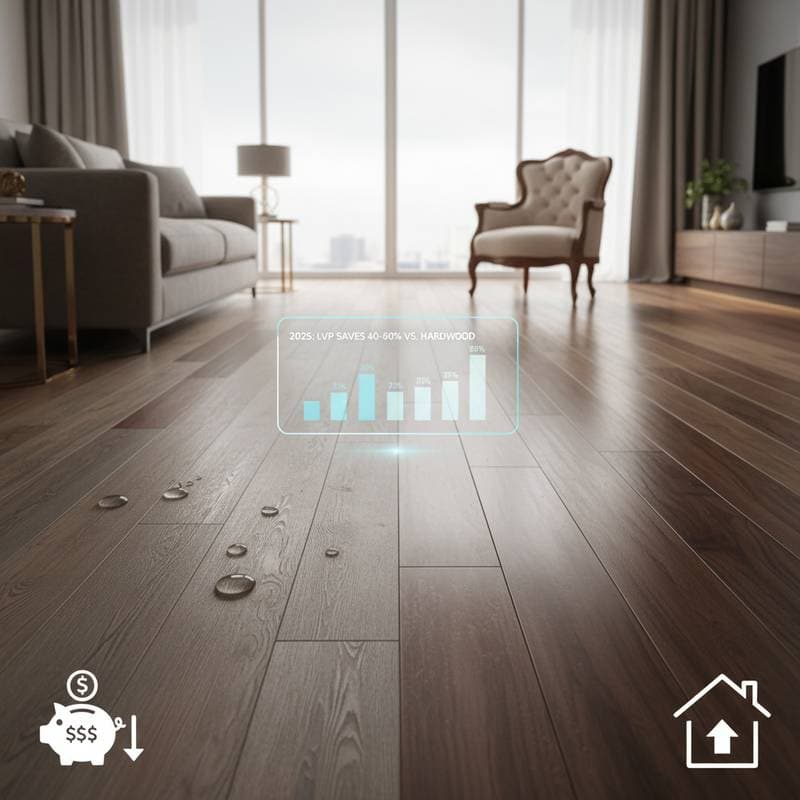Luxury Vinyl Plank vs Hardwood: The 2025 Value Comparison
Flooring selections shape the daily experience of a home, influencing aesthetics, functionality, and market appeal. Homeowners often weigh luxury vinyl plank against hardwood during full renovations or targeted updates. Each option presents distinct advantages in terms of expense, resilience, and financial returns, guiding informed decisions that align with personal priorities and fiscal constraints.
Breaking Down the Costs
Expenses for flooring depend on factors such as square footage, local installation fees, and product grades. National benchmarks offer a solid foundation for budgeting purposes.
| Flooring Type | Material Cost (per sq. ft.) | Installed Cost (per sq. ft.) | Typical Total for 1,000 sq. ft. |
|---|---|---|---|
| Luxury Vinyl Plank (LVP) | $2 - $5 | $4 - $7 | $4,000 - $7,000 |
| Engineered Hardwood | $4 - $9 | $8 - $13 | $8,000 - $13,000 |
| Solid Hardwood | $6 - $12 | $10 - $16 | $10,000 - $16,000 |
For a complete main-floor overhaul, luxury vinyl plank typically requires 40 to 60 percent less investment compared to hardwood alternatives. This difference becomes more pronounced when accounting for preparatory work on subfloors, new trim installations, and necessary underlayments.
Assessing Durability and Upkeep
Luxury Vinyl Plank Performance
Luxury vinyl plank withstands high-traffic environments, including households with active children or pets, while offering robust defense against spills and humidity. Maintenance involves sweeping debris and wiping surfaces with a solution of mild soap and water using a microfiber mop. High-quality versions feature wear layers ranging from 12 to 20 mils, supporting a service life of 15 to 25 years with proper care. These planks also demonstrate strong resistance to UV exposure and surface abrasions, outperforming basic laminates in everyday resilience.
Hardwood Resilience
Hardwood imparts a genuine, inviting texture that elevates interior spaces and endures for 40 to 50 years under diligent oversight. Owners must schedule refinishing sessions every 10 to 15 years, costing approximately $4 to $6 per square foot, to restore its finish. Environmental controls prove essential, as fluctuations in moisture levels can lead to expansion, contraction, or deformation of the wood.
Residents in areas with elevated humidity or risks of water damage benefit from the impermeable qualities of luxury vinyl plank. Those committed to natural elements and extended occupancy find hardwood's adaptability through multiple refinishes particularly rewarding.
Practical Strategies to Cut Costs in 2025
Target installation during slower seasons, such as late winter or early summer, when contractors frequently reduce labor charges by 10 to 20 percent. Consider hybrid approaches by placing hardwood in high-visibility zones like living rooms and opting for luxury vinyl plank in kitchens or bathrooms; this tactic can lower overall expenses by up to 25 percent without sacrificing cohesive styling.
Solicit bids from multiple sources, aiming for at least three detailed proposals from certified professionals to identify competitive pricing. Explore manufacturer promotions, including deferred payment plans spanning 6 to 12 months, alongside potential incentives from energy providers for eco-friendly flooring selections. Allocate an additional 5 percent of materials beyond project needs to address future repairs, such as replacing isolated damaged sections.
Obtain three complimentary estimates from nearby specialists to refine your flooring strategy.
Steps to Execute Your Flooring Upgrade
Homeowners anticipating long-term residency and desiring the authentic patina of a renewable surface will appreciate hardwood as a premium, enduring choice. For those seeking contemporary aesthetics, reliable performance, and humidity tolerance without substantial initial outlay, luxury vinyl plank emerges as the pragmatic frontrunner in 2025.
Time projects for spring or autumn to minimize moisture-related issues during installation. Conduct thorough subfloor evaluations prior to material procurement, ensuring evenness and dryness to avoid complications. Confirm that chosen installers hold certifications from product brands, safeguarding warranty coverage and workmanship quality.
Ultimately, either flooring type can revitalize a home's ambiance and usability. Align your selection with specific usage patterns and maintenance commitments to maximize satisfaction and property enhancement.
